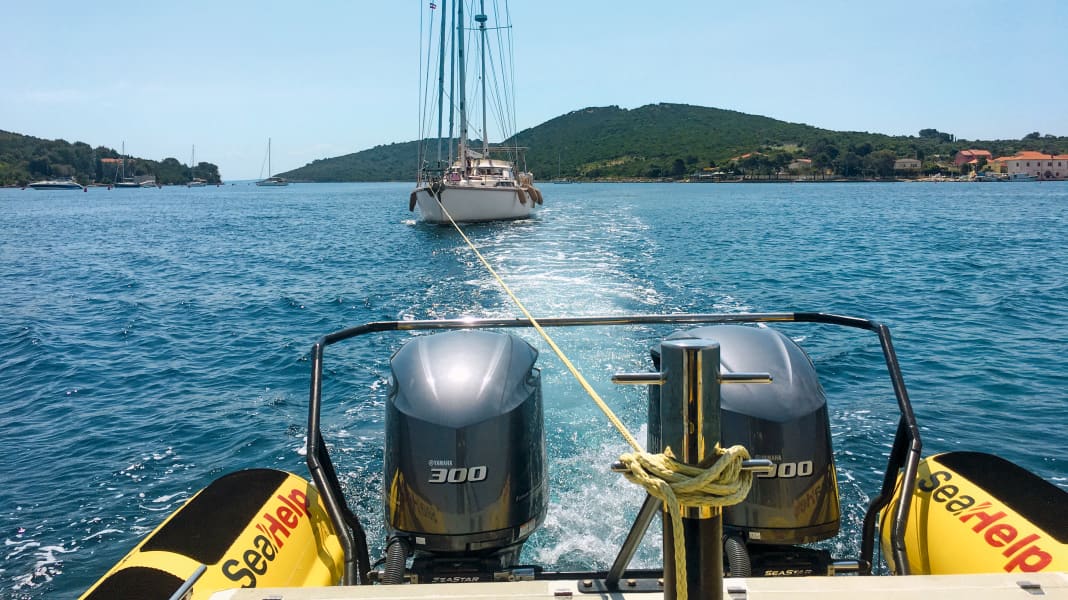
He set up his first boat breakdown service as a charter company: in 2008, Wolfgang Dauser simply wanted to be able to help his own charter customers more quickly if they called from en route due to a defect in their equipment or boat. The internal breakdown department gradually developed into an independent private company: SeaHelp. At its locations in Croatia, Italy, Slovenia, Germany, the Netherlands and Spain, SeaHelp now carries out well over 1,000 missions a year. The coronavirus pandemic has done little to change this; there has been no decline in numbers, on the contrary. In the YACHT interview, Wolfgang Dauser reports on developments that have never been seen before.
YACHT: Mr Dauser, your people were called out on 611 missions in Croatia alone in 2021 and had to help with technical problems four times as often as in the previous year. Is corona driving up the number of call-outs?
Wolfgang Dauser: You could say that! Due to the regular increase in corona numbers in autumn, an unusually large amount of the usual service work on the ships remained undone during wintering. In spring, the pandemic then subsides just as regularly. Suddenly, the situation in the workshops is tense, as everyone wants their boat ready for sea. Work that was previously spread out over five months is now concentrated within one to two months. Unlike in previous years, many owners have been unable to get a service appointment at all. There is a risk that this year, boat maintenance will once again drag on until early summer. As a result, many will sail off with inadequately serviced boats or none at all.
Have the reasons for the breakdown service call-outs remained the same?
Covid has significantly changed the statistics, initially downwards. In 2020, we observed that owners on the North and Central Adriatic did not move more than 20 to 30 nautical miles away from their moorings due to concerns about short-term pandemic developments. The southern Adriatic was practically not sailed at all in 2020. Cruising behaviour normalised in 2021. The focus was now back on long-distance holiday trips, but this time on boats that were not always well maintained, as described above. Most of the boats we had to help had seen their last proper service in 2019. Crews had left head over heels in August 2020 and often abandoned their boats in a hurry. The fridges were still running on some of them and many were left unattended on shore power for weeks.
What were the consequences?
2021 was the year of overheating engines. The list of causes is long: first and foremost were problems with engine cooling: impellers that had not been replaced; mussels in the cooling water system; overgrown cooling water inlets; contaminated fuel because the diesel had been in the tank for two years. In second place were problems with the batteries, which had not been charged regularly because owner boats could not be reached during the long lockdown phases.

In the face of such exceptional situations, are you still able to plan ahead at all?
That only works in the short term. However, my employees can predict what's coming just by listening to the weather forecast. The more perfect a high pressure situation develops in summer, the more assignments we have. We have most of them in the best conditions.
Because that's when most crews leave the marinas and are on the move?
Yes, in stable high-pressure conditions, even skippers with less experience have the confidence to spend the night at a buoy or at anchor. Crews then stay longer in bays, which leads to the typical fair weather problems on board: The fridge drains the batteries unnoticed; the anchor windlass quits working; the anchor gets stuck at the bottom in crevices. Last year, even after the summer, in September and especially in October, after the maintenance-related early summer damage had subsided, we continued to have an atypically high number of calls. This is because, unlike in the past, owners continued to use their boats well into the autumn out of concern about the next lockdown.
"Sometimes we can barely keep up with the calls. In 2019, we received 60 emergency calls on a stormy night!"
Are there other aspects of how the pandemic is affecting your operations?
2020 was a strange year. In spring, we didn't have any operations at all after the pandemic broke out - there was nothing going on due to the travel warnings. Suddenly, however, more and more calls came in because owners had cancelled their berths the previous year. The previous berth was gone, but the owners were unable to move their boat as planned due to the lockdown. Suddenly, they were faced with double mooring costs; boats with high daily fees were often moored on the expensive transit moorings. We were then asked if we could also move boats. We did that. But as we didn't have the keys, we had to tow the boats. In short, every year is different.
What has been your craziest year at SeaHelp so far?
This was without question the year 2019! A special weather situation with three thunderstorms on three consecutive days caused hardship for many sailors. We could barely keep up with the deployments.
What was going on?
Especially during storms in the Croatian high season, we can't deal with all the callers at the same time. Let me give you an example: On the night of Friday, 6 August 2019, violent thunderstorms raged over the central Adriatic from midnight. From two o'clock in the morning until ten o'clock in the morning, we received around 60 emergency calls. A large proportion of these - between 25 and 30 calls - concerned the rescue of stranded and sunken yachts.
What do you consider to be salvage and what perhaps still counts as towing assistance?
A salvage operation is necessary if a ship is so damaged by external influences or as a result of technical failure that its crew can no longer bring it into a harbour under its own power or if it is impossible to continue its journey under its own power. SeaHelp membership partially covers such operations. But when it comes to the total loss of the yacht and the threat of environmental damage, the operation is always chargeable. SeaHelp is not a rescue organisation, but a breakdown service.
In the event of a storm, is this caused solely by external factors such as strong gusts or wind seas? Or are people also involved when a boat has to be rescued?
Man is always involved: when he anchors a boat too close to the rocks; when he leaves a boat unmanned on Sveti Klement in a bay open to the north, the main weather direction, when there is a risk of thunderstorms. If a rescue is necessary, man is always involved as the cause of the accident. He is the one who makes the right or wrong decisions, not the boat.
What are the most common mistakes?
In 70 to 80 per cent of all cases, too little chain is used. Or the yacht was anchored too close to the rocks. The second most common cause in Croatia is that a buoy has not held and the yacht is drifting.
Are the buoys not safe?
Unfortunately, not always. Of the demolitions in 2021, 90 per cent occurred in officially designated buoy fields.
Do slipping base weights also play a role?
Not if they are done properly. A friend had a midnight thunderstorm with his 60-tonne motor yacht in a bay on Rava with peaks of up to 60 knots. He and I were hanging together on an anchor buoy with a shore mooring. Our yachts danced violently in the gusts. When I dived to the concrete block the next morning to check whether we had moved it, it hadn't moved an inch. The vacuum at the bottom holds the blocks in place more than you might think.
And where do the yachts' demolitions of buoys come from?
The rope or the shackle between the block and the buoy is often the weak point. There are also black sheep among buoy hire companies or restaurant owners who only sink a 100-kilo block or even just a parasol stand. You should always check what you are mooring to.
Do you have more to do with sailing or motor yachts?
63 per cent of our members are motorboat owners, only 37 per cent are sailors. When it comes to operations, however, the picture is the other way round: 70 per cent of all operations are for sailing vessels, only ten per cent for motor yachts. Smaller pleasure craft account for 20 per cent. And although there are around 5,000 sailing yachts and 1,000 motor yachts on charter in Croatia, over 80 per cent of our operations are for private owners.
"70 per cent of our missions are for sailing yachts - although we have many more motorboat drivers than members"
How do you explain the fact that sailors need your help twice as often?
Well, the typical skipper of a private motor yacht is over 60 years old and on holiday alone with his wife. On sailing yachts, there are families with children or larger crews, who shower more often and consume more electricity, charge and use more laptops, mobile phones and tablets. The problem that occurs most frequently is power failure. Another point: motor yachts have two engines and therefore two alternators, whereas sailing yachts only have one. We also often have to deal with rigging problems or jammed furling sails. Rig maintenance on sailing yachts is virtually non-existent and neglected. Probably also because many private owners want to save themselves the expense or think they can repair many things themselves.
If sailing yacht owners repair more themselves: Why is your breakdown service necessary at all? Sailors used to help each other, whether in the harbour or at sea.
Unfortunately, the willingness to help others has declined dramatically. It is not an isolated case, for example, that crowds of crews pass another drifting boat and only wave in a friendly manner, even though the skipper is gesticulating frantically and asking for help. And something else has changed: People have become more impatient. In 2005, people were happy if we were on site after an hour and a half. Today, we often hear complaints after half an hour that they can't continue their holiday because we're not there yet.
What do you expect for 2022?
2021 was the year of engine defects. Strangely enough, 2013 was the year of defective starter and armature relays. It's hard to say what will happen this season.
Do you expect even more holidaymakers on the Croatian coast than last year?
That's hardly possible anymore. There have probably never been so many holidaymakers on the water in Croatia in 2021. It was a sensational year, at least according to the restaurant owners. I think 2022 will be a bit more predictable. After two coronavirus seasons, everyone has gained enough experience. However, the trend towards boat tourism will continue to grow, as many have experienced its benefits for themselves and told their friends about it.
The interview was conducted by Thomas Käsbohrer. It appeared in YACHT 8/2022 as part of our in-depth Croatia special. Did you miss the issue? No problem, you can reorder it here (just click!).

